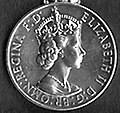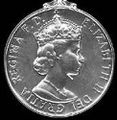Award
| Police Long Service and Good Conduct Medal | |
|---|---|
  Obverse and reverse of the medal Obverse and reverse of the medal | |
| Type | Long service medal |
| Awarded for | 20 years of service |
| Presented by | the United Kingdom |
| Eligibility | 20 years full or part time service as a Police Officer |
| Clasps | 30 and 40 Years Service Clasp |
| Status | Currently awarded |
| Established | 14 June 1951 |
| Order of Wear | |
| Next (higher) | Indian Meritorious Service Medal (British Indian Army) |
| Next (lower) | Fire and Rescue Service Long Service and Good Conduct Medal |
The Police Long Service and Good Conduct Medal is a decoration for police officers of the United Kingdom. First instituted in 1951, the medal is presented for twenty aggregate years of service in the police services of the United Kingdom.
Criteria
The Police Long Service and Good Conduct Medal was instituted under Royal Warrant by King George VI in June 1951 and is awarded as a mark of the Sovereign's appreciation of long and meritorious service rendered by members of the Police Forces of the United Kingdom. For an officer to become eligible for this award the Chief Constable must make a recommendation to the Home Secretary, and in doing so, is required to certify the following:
- That an officer has been a serving member of a Police Force.
- That the officer has served efficiently for the qualifying period.
- That the officer's character has been very good.
Commonwealth
In 1956 eligibility was extended to police officers serving in Australia, Papua New Guinea and Nauru. In 1976 Australia replaced the award with the National Medal and, in 2010, with the National Police Service Medal.
Length of service
The initial award criterion was 22 years' service as a full-time regular police officer within any Constabulary.
Later, Long Service and Good Conduct Medals were introduced for the Fire Brigade and Ambulance Service, both awarded for 20 years’ service. A national campaign to award the police medal after 20 years, and so bring it in line with the other emergency services, was started by Warwickshire Police Officer Kenneth Fowler, supported by Chief Officers, the Police Federations and Members of Parliament. On 19 January 2010, Queen Elizabeth II amended the medal's royal warrant to make the qualifying period of service 20 years.
Clasps
In March 2022, the Royal Warrant was updated by Queen Elizabeth II to grant clasps to officers who completed a further 10 and 20 years of long service post award of the medal. This change reflected the longer service of Police Officers following pension changes and sought to recognise their extended service. The two clasps are in cupronickel, and bear the inscription below:
- 'Long Service, 30 Years'
- 'Long Service, 40 Years'
Appearance
The medal is circular, 1.4 inches (36 mm) in diameter and initially issued in cupro-nickel, with modern strikings being rhodium plated. It has the following design:
- The obverse bears the effigy of the reigning monarch
- The reverse has the figure of Justice with scales in her left hand and a wreath in her right surrounded by the inscription 'FOR EXEMPLARY POLICE SERVICE'.
- The suspender is straight and found in both swivelling and non-swivelling formats.
- It is engraved on the rim in impressed capital letters, with the recipients rank and name. As of circa 2006 officers from the four Welsh constabularies have the option to have their rank engraved in Welsh.
- It hangs from a dark blue ribbon, 1.25 inches (32 mm) wide, with two thin white stripes towards each edge.
- Bars for additional service of 30 and 40 years, were authorised on 11 March 2022. However officers had to be serving on this date, the award is not retrospective to officers who retired prior to this date.
Obverse variations
The medal has been awarded with one of three obverse designs:
-
 George VI (1951–53)
George VI (1951–53)
-
 Elizabeth II 'BR OMN' (1953 to mid-1950s)
Elizabeth II 'BR OMN' (1953 to mid-1950s)
-
 Elizabeth II 'DEI GRATIA' (From mid-1950s)
Elizabeth II 'DEI GRATIA' (From mid-1950s)
See also
References
- ^ "No. 59482". The London Gazette. 7 July 2010. p. 12881.
- ^ "No. 56878". The London Gazette (Supplement). 17 March 2003. p. 3353.
- ^ Captain H. Taprell Dorling. Ribbons and Medals. pp. 118–119. Published A.H.Baldwin & Sons, London. 1956.
- ^ John W. Mussell, editor. Medal Yearbook 2015. p. 256. Published Token Publishing Limited, Honiton, Devon. 2015.
{{cite book}}:|author=has generic name (help) - National Police Service Medal, It's an Honour – Australian Government Website
- John W. Mussell, editor. Medal Yearbook 2015. pp. 252 and 266. Published Token Publishing Limited, Honiton, Devon. 2015.
{{cite book}}:|author=has generic name (help) - "Warwick policeman's campaign taken to Parliament". Leamington Courier. 4 February 2009. Retrieved 29 May 2012.
- "Staff associations secure medal recognition for long-serving police officers". Police Superintendents' Association. Retrieved 10 January 2023.
- "Additional Service Bar for Police Long Service and Good Conduct Medal".